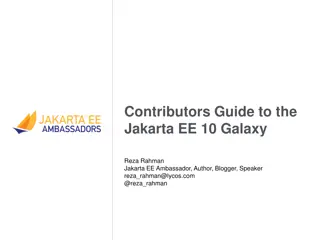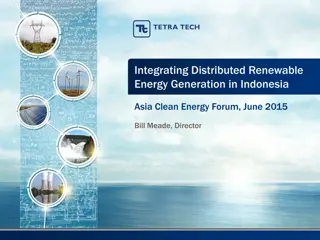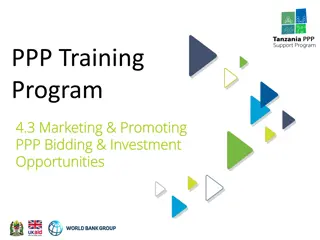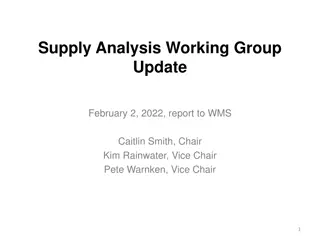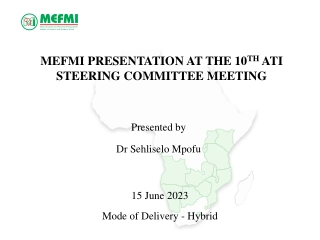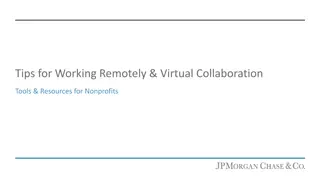Market Analysis and Promotion Strategy for Rooftop PV in Collaboration with Airlangga University and PLN Jakarta
The collaboration between Airlangga University and PLN Jakarta aims to analyze the market characteristics and develop a promotion strategy for rooftop PV. With a focus on reducing CO2 emissions, this initiative addresses the global challenge of sustainability by leveraging renewable energy sources. The joint efforts of researchers and industry experts seek to drive the adoption of rooftop PV systems for a greener and more sustainable future.
Download Presentation

Please find below an Image/Link to download the presentation.
The content on the website is provided AS IS for your information and personal use only. It may not be sold, licensed, or shared on other websites without obtaining consent from the author. Download presentation by click this link. If you encounter any issues during the download, it is possible that the publisher has removed the file from their server.
E N D
Presentation Transcript
Analysis of Market Characteristics and Promotion Strategy of Rooftop PV Airlangga University Cooperation and Development Management Agency & Center for Research and Development of Electricity PLN Jakarta
General Description General Description World CO2 Growth 40,000 35,000 30,000 25,000 20,000 15,000 10,000 5,000 0 1980 1960 1962 1964 1966 1968 1970 1972 1974 1976 1978 1982 1984 1986 1988 1990 1992 1994 1996 1998 2000 2002 2004 2006 2008 2010 2012 2014 2016 Emisi CO2 Source: World Bank (2020)
Indonesia's total energy consumption in 2018 reached 114 MTOE, consisting of: 40% of the transportatio n sector 36% 16% of the household sector 6% 2% other sectors industrial sector commercial sector *96% of fuel is dominated by energy, while the rest is supplied by biodiesel and natural gas *Dominated by electricity, is predicted to increase from 60% (2018) to 90% (2020) *The majority comes from natural gas and coal
The household sector has the largest consumption of electrical energy when compared to other sectors. According to Santoso & Salim (2019) the distribution of electricity sales to the household sector is 93,634.63 GW or the equivalent of 49.26% of total electricity sales. High energy consumption can lead to scarcity as Indonesia's population growth has increased significantly It is necessary to use alternative energy sources so that energy availability can meet the needs of future generations Some of the potential energies as a substitute for non-renewable energy include hydropower, geothermal, bio-power plants, biofuel, solar, wind and marine energy. Hydropower has the potential to generate 94.3 GW; geothermal 28, 32.65 GW; GW bio PLT; BBN 200 thousand Bph; solar 207.8 GWp; wind 60.6 GW; and 17.9 GW of marine energy
Solar energy has the greatest potential, namely 207.8 GWp ESDM Minister Regulation No. 49 of 2018 to encourage the use of solar energy as a new and renewable energy Security requirements for the installation of rooftop solar panels that must comply with certain standards, one of which is the PT Perusahaan Listrik Negara (PLN) standard.
Ministry of Energy and Mineral Resources Policy No. 49 in 2018 The growth of rooftop solar panels in April 2020 reached 17% compared to December 2019 (PT PLN, 2020) 20% decrease in revenue at PLN Main Distribution Unit (UID) Jakarta Raya when customers start using rooftop solar panels. PT PLN needs to enter the PV Rooftop market as an anticipation of the decline in sales of PLN's main business, namely conventional electricity due to the rapid growth of the PV Rooftop business. PT PLN can accelerate the target of achieving the use of the EBT level of 23% by 2025 As a solution to meet customer demands in Green Energy. PT PLN can determine the right promotional strategy in targeting target consumers Analysis of the characteristics of the PV Rooftop market in Indonesia, the current position of PT PLN in the PV Rooftop market in Indonesia, and the benefits for each customer who installs PV Rooftop Reviewing financing schemes for customers related to savings and financing for purchasing PV Rooftop with credit schemes & projected losses for PT PLN
Solar PV System Solar PV System On-grid distributed Grid-connected centralized On-grid Off-grid domestic Off-grid non domestic Off-grid Hybrid Combined on-grid and off-grid systems
Government Policy Regarding Solar Power Government Policy Regarding Solar Power Development Development Rooftop Photovoltaic Solar Systems (RPVSS) Feed-In-Tariff Local Fare Policy Providing these incentives to stimulate market growth Only lasted 1 year (2013-2014) Ministry of Energy and Mineral Resources No. 12/2017 The price the developer gets is a predetermined local rate. Made in 2018 PLN customers can generate electricity supply independently from the solar PV system Customers can export excess electricity to the national grid for 65% of the full retail rate.
PV Rooftop Customer Procedure PV Rooftop Customer Procedure 1. Customers apply for a subscription to the rooftop PV system by attaching some administrative and technical requirements 2. PLN evaluates the administrative and technical requirements no later than 15 working days after the complete documents are received. 3. Business entities carry out the construction and installation of PV rooftops and inspection of PV rooftop installations to issue an Operation Acceptable Certification (SLO). 4. The customer pays the cost of supplying and installing the export-import kWh meter. 5. The PLN unit provides and installs import-export kWh meters.
Rooftop PV Marketing Strategy Based on Previous Studies Rooftop PV Marketing Strategy Based on Previous Studies Social Marketing Strategy (Eagel et al, 2017) Cost-Performance (Noguchi, 2005) Balance Score Card (Bach dkk, 2001) Integrating all the interests of stakeholders, including owners, customers, employees, and others on the scorecard. How to communicate to influence homeowners to want to switch to energy saving power. The value-added production approach by setting a higher standard on house building. Educational programs such as newsletters, the internet, and applications can be a solution for respondents who lack information. A bulk custom design approach that can reduce production costs by achieving economies of scope. BSC tries to provide a balanced impact report that is holistic and value- based.
Example of the Basic Model of EBT Business in Japan Example of the Basic Model of EBT Business in Japan Aggregation Model Based on FIT Source This model is based on the national aggregation scale on a number of small-scale solar panels such as households and companies Renewable Energy Service Provider Integrated Model The energy producers are owned by the company and sold under the FIT energy source Centralized City Balancing Group Model Solar power arrangements are focused at the city level with local companies joining joint ventures Regional Retail Energy Sources by Consumption Cooperatives Through cooperatives, the distribution of renewable energy sales can be accelerated
Methodology Methodology Qualitative (FGD, Questionnaire, In-depth Interview) Quantitative (Descriptive statistical analysis of primary data) Approach Types and Sources of Data Primary data (results of interviews or answers to questionnaires from respondents) Secondary data (publications and information from the State Electricity Company (PLN), journals, etc.) Offline survey in Jakarta, East Java, Bali Estimation: 500 respondents (250 Existing, 250 Potential) Realization: 323 respondents (117 Existing, 206 Potential) Data collection Validity and Reliability Test The accuracy of the data obtained on the object of research with the data reported by the researcher Knowing the consistency of research instruments on the results achieved in different situations Descriptive Statistics Analysis SWOT analysis Analysis Technique
Aggregate Aggregate Respondents Respondents
Profile of Aggregate Rooftop PV Respondents Profile of Aggregate Rooftop PV Respondents 186 57,6% 200 180 160 Numbe rof Respondents 140 100 30,9% 120 100 80 60 17 5,3% 40 9 8 1 2 2,8% 2,5% 20 0,3% 0,6% 0 Bali Batu Jakarta Malang Pamekasan Sumenep Surabaya Origin Origin of Aggregate Respondents
Profile of Aggregate Rooftop PV Respondents Profile of Aggregate Rooftop PV Respondents 120 108 Number of Respondents 100 74 80 Female 36% 68 60 45 40 Male 64% 21 20 7 0 11-20 21-30 31-40 41-50 51-60 61-70 Age Range Profile of Respondents Based on Age Ranges Profile of Respondents Based on Gender
Profile of Aggregate Rooftop PV Respondents (Household) Profile of Aggregate Rooftop PV Respondents (Household) 140 125 120 109 Number of Respondents Out of town 11% 100 80 Downtown 46% 60 40 Suburban 43% 16 20 7 6 0 ES JHS SHS Bachelor Master Education Profile of Respondents Based on Residence Location Profile of Respondents Based on Education
Profile of Aggregate Rooftop PV Respondents (Household) Profile of Aggregate Rooftop PV Respondents (Household) 90 83 Farmer 1 80 Number of Respondents Name of Occupation Farm worker 2 70 60 54 Civil servant/Police 18 46 50 44 Private employee 90 40 Enterpreneur 94 30 19 17 20 Odd jobs 14 10 Other 44 0 0 20 Number of Respondents 40 60 80 100 <3 3 4 5 6 6< Number of Household Members Profile of Respondents Based on the Number of Household Members Profile of Respondents Based on Occupation
Monthly Income of Household Rooftop PV Respondents Monthly Income of Household Rooftop PV Respondents Income Respondent < 5 million 77 5,1 - 10 million 75 10,1 - 15 million 36 15,1 - 20 million 27 20,1 - 25 million 13 25,1 - 30 million 16 30,1 - 35 million 5 35 million < 14
Profile of Aggregate Rooftop PV Respondents (Industry) Profile of Aggregate Rooftop PV Respondents (Industry) Individual Company 18 Limited Partnership 6 Form of Business Production 35% Incorporated Company 15 Agency Company 1 Services 65% Foundation 8 Other 12 0 5 10 15 20 Number of Respondents Profile of Respondents Based on Type of Business Profile of Respondents Based on Form of Business
Profile of Aggregate Rooftop PV Respondents (Industry) Profile of Aggregate Rooftop PV Respondents (Industry) 1-5 Km 30 6-10 Km 13 Distance 11-15 Km 6 15-20 Km 2 More than 20 Km 9 0 5 10 15 20 25 30 35 Number of Respondents Profile of Respondents Based on Business Location from City Center
Respondents of Respondents of Existing Existing Household Household
Profile of Existing Household Rooftop PV Respondents Profile of Existing Household Rooftop PV Respondents 60 50 (56.2%) 50 Number of Respondents 40 28 (31.5%) 30 20 4 3 3 10 1 (4.5%) (3.4%) (3.4%) (1.1%) 0 Bali Jakarta Malang Pamekasan Origin Sumenep Surabaya Origin of Existing Household Rooftop PV Respondents
Profile of Existing Household Rooftop PV Respondents Profile of Existing Household Rooftop PV Respondents 35 31 30 Number of Respondents 25 Female 30% 20 20 17 15 11 Male 70% 10 6 4 5 0 11-20 21-30 31-40 41-50 51-60 61-70 Age Range Profile of Respondents Based on Gender Profile of Respondents Based on Age Ranges
Profile of Existing Household Rooftop PV Respondents Profile of Existing Household Rooftop PV Respondents 60 Out of Town 25% Number of Respondents 48 50 40 Downtown 38% 28 30 20 10 10 1 1 1 0 ES JHS SHS Bachelor Master Doctoral Suburban 37% Education Profile of Respondents Based on Education Profile of Respondents Based on Residence Location
Profile of Existing Household Rooftop PV Respondents Profile of Existing Household Rooftop PV Respondents 30 27 Farm worker 1 25 Number of Respondents 25 Farmer 1 20 Enterpreneur Occupation 30 16 15 Civil servant/Police 5 15 Private employee 31 10 6 Odd jobs 6 5 Other 15 0 <3 4 5 6 6< 0 5 10 Number of Respondents 15 20 25 30 35 Number of Household Members Profile of Respondents Based on Household Members Profile of Respondents Based on Occupation
Monthly Income of Existing Household Rooftop PV Monthly Income of Existing Household Rooftop PV Respondents Respondents Income Respondent < 5 million 16 5,1 - 10 million 11 10,1 - 15 million 17 15,1 - 20 million 16 20,1 - 25 million 4 25,1 - 30 million 10 30,1 - 35 million 4 35 million < 11
Profile of Existing Household Rooftop PV Respondents Profile of Existing Household Rooftop PV Respondents More than 400 m2 16 Annual rent 2 Home Ownership 301 m2 400 m2 14 House Size Monthly rent 1 201 m2 300 m2 16 One's own 68 100 m2 200 m2 36 Owned by family/relatives 18 Less than 100 m2 7 0 10 Number of Respondents 20 30 40 0 20 40 60 80 Number of Respondents Profile of Respondents Based on House Size Profile of Respondents Based on Home Ownership
Profile of Existing Household Rooftop PV Respondents Profile of Existing Household Rooftop PV Respondents 6600 VA and above(R-3) 13 6600 VA and above (R-3) 14 Electrical Power Electrical Power 3500 VA - 5500 VA (R-2) 22 3500 VA - 5500 VA (R-2) 32 450 VA - 2200 VA (R-1) 450 VA - 2200 VA (R-1) 54 43 0 10 20 30 40 50 60 0 10 20 30 40 50 Number of Respondent Number of Respondent Electrical Power of Existing Household Respondents Before Rooftop PV Installation Electrical Power of Existing Household Respondents After Rooftop PV Installation
Number of Electronic Items from Existing Household Number of Electronic Items from Existing Household Rooftop PV Respondents Rooftop PV Respondents Name of Electronic Number of Electronic Items 0 1 2 3 4 5 5< Total Items Refrigerator 2 49 28 8 2 0 0 89 Television 4 19 24 15 19 4 4 89 Air Conditioning 13 9 18 15 13 9 12 89 Dispenser 18 48 20 1 2 0 0 89 Washing Machine 15 60 14 0 0 0 0 89 Electric Stove 60 22 7 0 0 0 0 89 Computer 13 17 23 16 5 6 9 89 Electric Vehicle 87 2 0 0 0 0 0 89
Respondents of Respondents of Potensial Potensial Household Household
Profile of Profile of Potensial Potensial Household Rooftop PV Respondents Household Rooftop PV Respondents 124 140 (71.3%) 120 Number of Respondent 100 80 60 30 40 (17.2%) 12 4 3 1 (6.9%) 20 (2.3%) (1.7%) (0,6%) 0 Bali Batu Jakarta Malang Pamekasan Surabaya Origin Origin of Potensial Household Rooftop PV Respondents
Profile of Profile of Potensial Potensial Household Rooftop PV Respondents Household Rooftop PV Respondents 80 73 70 Number of Respondents 60 50 37 Female 41% 40 30 24 23 Male 59% 20 14 10 3 0 11-20 21-30 31-40 41-50 51-60 61-70 Age Range Profile of Respondent Based on Age Ranges Profile of Respondent Based on Gender
Profile of Profile of Potensial Potensial Household Rooftop PV Respondents Household Rooftop PV Respondents 90 81 77 80 Number of Respondent 70 Out of town 8% 60 50 Downtown 47% 40 30 Suburban 45% 20 6 5 5 10 0 ES JHS SHS Bachelor Master Education Profile of Respondent Based on Education Profile of Respondent Based on Residence Location
Profile of Profile of Potensial Potensial Household Rooftop PV Respondents Household Rooftop PV Respondents 56 60 Farm worker 1 Number of Respondents 46 50 Enterpreneur 64 40 Occupation Civil servant/Police 13 30 27 30 Private employee 59 20 11 Odd jobs 8 10 4 Other 29 0 <3 3 4 5 6 6< 0 10 20 Number of Respondents 30 40 50 60 70 Number of Household Members Profile of Respondent Based on Occupation Profile of Respondent Based on Household Members
Monthly Income of Monthly Income of Potensial Potensial Household Rooftop PV Household Rooftop PV Respondents Respondents Income Respondent < 5 million 61 5,1 - 10 million 64 10,1 - 15 million 19 15,1 - 20 million 11 20,1 - 25 million 9 25,1 - 30 million 6 30,1 - 35 million 1 35 million < 3
Profile of Profile of Potensial Potensial Household Rooftop PV Respondents Household Rooftop PV Respondents More than 400 m2 4 Annual rent 9 Home Ownership 301 m2 - 400 m2 14 Monthly rent 13 House Size 201 m2 - 300 m2 28 One's own 112 100 m2 - 200 m2 63 Owned by family/relatives 40 Less than 100 m2 65 0 10 20 Number of Respondents 30 40 50 60 70 0 20 40 60 80 100 120 Number of Respondents Profile of Respondent Based on House Size Profile of Respondent Based on Home Ownership
Profile of Profile of Potensial Potensial Household Rooftop PV Respondents Household Rooftop PV Respondents 3500 VA - 5500 VA (R-2) 18 Electrical Power 450 VA - 2200 VA (R-1) 156 0 20 40 60 80 100 120 140 160 180 Number of Respondents Electrical Power of Potensial Household PV Rooftop Respondents
Number of Electronic Items from Number of Electronic Items from Potensial Rooftop PV Respondents Rooftop PV Respondents Potensial Household Household Name of Electronic Number of Electronic Items 0 1 2 3 4 5 5< Total Items Refrigerator 11 131 28 4 0 0 0 174 Television 4 101 40 18 7 1 3 174 Air Conditioning 55 62 27 15 11 3 1 174 Dispenser 49 112 11 2 0 0 0 174 Washing Machine 36 127 10 1 0 0 0 174 Electric Stove 149 22 3 0 0 0 0 174 Computer 65 71 25 11 0 1 1 174 Electric Vehicle 172 2 0 0 0 0 0 174
Respondents of Respondents of Existing Industry Existing Industry
Profile of Existing Industry PV Rooftop Respondents Profile of Existing Industry PV Rooftop Respondents 15 16 (55.6%) 14 Number of Respondents 10 12 (37%) 10 8 6 4 1 1 2 (3.7%) (3.7%) 0 Bali Jakarta Malang Sumenep Origin Origin of Existing Industry PV Rooftop Respondent
Profile of Existing Industry PV Rooftop Respondents Profile of Existing Industry PV Rooftop Respondents 7 6 6 6 Number of Respondents 5 Female 26% 4 4 4 3 3 2 2 Male 74% 1 1 1 0 21-25 26-30 31-35 36-40 Age Range 36-41 41-45 46-50 51-55 Profile of Respondents Based on Age Ranges Profile of Respondents Based on Gender
Profile of Existing Industry PV Rooftop Respondents Profile of Existing Industry PV Rooftop Respondents Individual Company 9 Limited Partnership 3 Form of Business Incorporated Company 5 Suburban 44% Agency Company 1 Downtown 56% Foundation 2 Others 7 0 2 4 6 8 10 Number of Respondents Profile of Respondents Based on the Form of Business Profile of Respondents Based on Business Location
Profile of Existing Industry PV Rooftop Respondents Profile of Existing Industry PV Rooftop Respondents 12 10 10 Number of Respondents 8 Production 37% 6 4 4 3 3 3 Services 63% 2 2 2 0 Informatics Food Clothes Education Property Solar Panels Others Type of Business Profile of Respondents Based on Type of Business Profile of Respondents Based on the Business Sector
Profile of Existing Industry PV Rooftop Respondents Profile of Existing Industry PV Rooftop Respondents More than 400 m2 More than 20 Km 11 2 301 m2 - 400 m2 15-20 Km 1 2 Industry Area Distance 201 m2 - 300 m2 11-15 Km 4 4 100 m2 - 200 m2 6-10 Km 9 5 Less than 100 m2 1-5 Km 2 14 0 2 4 6 8 10 12 0 2 4 6 8 10 12 14 16 Number of Respondents Number of Respondents Profile of Respondents Based on Area Profile of Respondents Based on the Distance from City Center
Profile of Existing Industry PV Rooftop Respondents Profile of Existing Industry PV Rooftop Respondents 12 12 11 10 Number of Respondents Number of Respondents 10 10 9 8 8 7 6 6 5 4 4 4 4 3 2 2 1 0 0 <5 5-10 Number of Rooms 11-15 15< <10 10-20 21-30 31-40 40< Number of Workers Profile of Respondents Based on Number of Rooms Profile of Respondents Based on Workers
Respondents of Respondents of Potensial Potensial Industry Industry
Profile of Profile of Potensial Potensial Industry Rooftop PV Respondents Industry Rooftop PV Respondents 19 (57.6%) 20 18 Number of Respondents 16 14 10 12 (30.3%) 10 8 6 2 1 1 4 (6.1%) (3%) (3%) 2 0 Bali Jakarta Malang Pamekasan Surabaya Origin Origin of Potensial Industry Rooftop PV Respondents
Profile of Profile of Potensial Potensial Industry Rooftop PV Respondents Industry Rooftop PV Respondents 8 7 7 Number of Business 6 5 5 Female 27% 5 4 4 4 3 3 3 2 2 Male 73% 1 0 <21 21-25 26-30 31-35 Age Range 36-40 41-45 46-50 51-55 Profile of Respondents Based on Age Ranges Profile of Respondents Based on Gender
Profile of Profile of Potensial Potensial Industry Rooftop PV Respondents Industry Rooftop PV Respondents Individual Company 9 Form of Business Limited Partnership 3 Incorporated Company 10 Suburban 48% Downtown 52% Foundation 6 Others 5 0 2 4 6 8 10 12 Number of Respondents Profile of Respondents Based on the Form of Business Profile of Respondents Based on Business Location
Profile of Profile of Potensial Potensial Industry Rooftop PV Respondents Industry Rooftop PV Respondents 18 16 16 Number of Respondents 14 12 Production 33% 10 8 5 5 6 4 Services 67% 3 4 2 0 Food Clothes Education Type of Business Property Others Profile of Respondents Based on Type of Business Profile of Respondents Based on Business Sector


